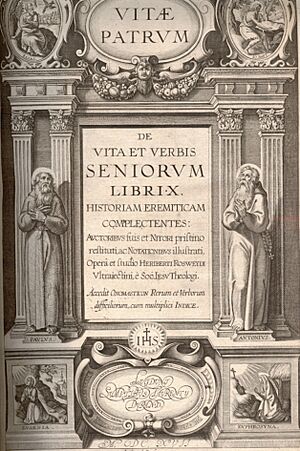Heribert Rosweyde facts for kids
Heribert Rosweyde (born January 20, 1569, in Utrecht – died October 5, 1629, in Antwerp) was a Jesuit priest who studied and wrote about the lives of saints. He is known for starting a huge project to collect and publish these stories. Even though he didn't finish it, his work was continued by Jean Bolland and led to the famous group known as the Bollandists.
Contents
Early Life and Education
Heribert Rosweyde was born in Utrecht on January 20, 1569. His family was part of the Catholic community there. He went to the university in Douai and joined the Society of Jesus (the Jesuits) in 1588. Later, he became a professor of philosophy at the Jesuit college in Douai.
His Big Idea: Collecting Saints' Lives
Rosweyde loved spending his free time in the libraries of old monasteries. He visited places like Hainaut and French Flanders. He carefully copied many old documents about church history, especially about the lives of saints. He noticed that many newer versions of these stories had been changed. Rosweyde believed it was important to publish the original, unchanged texts.
Planning the Project
In 1603, Rosweyde shared his idea with his Jesuit leaders. They liked his plan and allowed him to start preparing his huge collection. At this time, he was working in Antwerp. He later moved to St Omer for a short time before returning to Antwerp in 1606.
Rosweyde found about 1300 old handwritten books about saints in libraries across Belgium. He managed to get copies of most of them. In 1607, he publicly announced his project. He even published a small book called Fasti sanctorum (which means "Calendar of Saints"). This book listed the names of saints whose stories he had found. It also explained how he planned to organize his massive work.
A Huge Collection of Stories
Rosweyde planned for his collection to have sixteen large volumes, plus two extra books for notes and tables.
- The first three volumes would cover the lives of Jesus Christ, the Virgin Mary, and other important saints.
- The next twelve volumes would feature saints whose feast days are celebrated in each month of the year (one volume per month). His superiors preferred this calendar order over his own idea of chronological order.
- The sixteenth volume would contain different lists of martyrs and saints used throughout history.
He also planned two extra volumes with lots of helpful information. These would include notes about the authors of the stories, details about martyrs' sufferings, and even pictures of saints.
Detailed Tables and Indexes
The second extra volume was going to have many detailed tables. These tables would help readers find information easily. They would list:
- The names of all the saints.
- Where each saint was born, what they did, and when and where they lived.
- Their role in the Church (like priest, bishop, or nun).
- Countries where saints were born or lived.
- Places where saints are especially honored.
- Illnesses that saints are invoked for healing.
- Professions that saints are patrons of.
- Names of people and places mentioned in the stories.
- Passages from the Bible explained in the stories.
- Points useful for religious discussions or teaching.
Rosweyde hoped readers would even suggest more ideas for these tables!
Challenges and Support
When Rosweyde sent a copy of his plan to Cardinal Bellarmine, the Cardinal was surprised. He reportedly said, "This man counts, then, on living two hundred years longer!" Bellarmine thought the plan was too ambitious and suggested Rosweyde focus on saints whose stories hadn't been published yet.
However, Rosweyde didn't give up. He received a lot of encouragement and help from others. A special supporter was Antoine de Wynghe, the abbot of Liessies Abbey. He helped Rosweyde by writing letters of recommendation, which opened up monastery libraries. He also lent books, gave manuscripts, and provided money.
Unfinished Work and Lasting Legacy
Rosweyde hoped to finish the project himself. But he was very busy with other duties. In 1609, he was sent to Courtrai, and later had to take on more responsibilities when a colleague died. He also wrote many other historical and religious books. Some of these might have been part of his big saint project, but many were not related at all.
When Rosweyde died in Antwerp in 1629, not a single page of his huge saint project was ready to be printed.
However, his hard work was not wasted. Jean Bolland was given the task of looking through all of Rosweyde's papers and documents. Bolland quickly saw how valuable they were. He decided to continue Rosweyde's massive project. The first volume of the Acta Sanctorum (meaning "Deeds of the Saints") was finally published in 1643. This was the beginning of the famous group of scholars known as the Bollandists, who continue to study and publish the lives of saints to this day.
Other Works
Besides his main project, Rosweyde also published other important works:
- Vitae patrum: This was a collection of ten books about the Lives of the Fathers of the Desert. He first published it in Latin in 1615 and later in Dutch in 1617.
- He also edited a version of the Little Roman Martyrology and the martyrology of Ado of Vienne (1613).
- Rosweyde also commissioned an art book called Sylva Anachoretica (1619), which featured fifty engravings of hermits.
He also translated other religious works into Dutch, such as Ribadeneira's Flowers of the Saints and a history of the Church in the Netherlands. He translated the lives of St. Ignatius and St. Philip Neri into Flemish.


